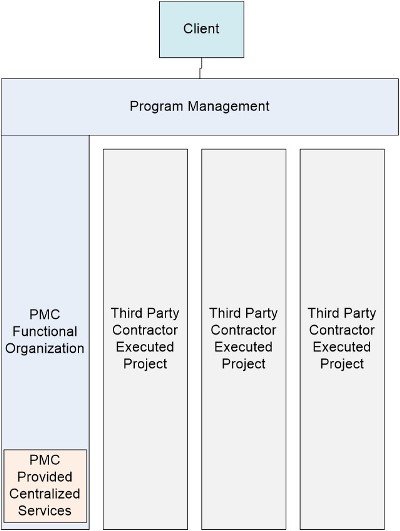in Large Engineering and Construction Programs
SECOND EDITION
By Bob Prieto
Jupiter, Florida, USA
Large corporate organizations typically employ some form of matrix organization to ensure a consistent approach in key areas across the organization. The nature and extent of this matrix or functional organization will be driven by:
- common approaches to human resources
- consistent application of legal approvals and reviews of significant actions
- common financial functions related to accounting, cash management, insurance and claims & suits
- common managerial, technical and support functions which accrue benefits from a consistent and coordinated approach
Within a project setting, required resources generally reside at the project level and corporate functional activities extend into the project environment only to the extent required to protect the parent organization, consistent with client requirements and practices.
The situation in large programs, however, is different and a functional organization more akin to the corporate functional organization is often created within the program team. This program level functional organization acts much in the same way as the corporate functional organization but its role and emphasis evolves throughout the programs life.
A typical program management organization will include a functional organization that will provide people, management processes, program-level project control tools, and systems. The program management team will thereby bring enhanced management, quality control, efficiency, and coordination to the entire program.

Conceptually, the program management organization might consist of the following major project execution elements:
- Program management
- Business and Administration Management
- HSE and security
- Human resources
- Project controls
- Estimating
- Procurement
- Material Management
- Contracting
- Interface management
- Risk management
- Information technology (IT)
- Quality
- Engineering management
- Construction management
- Program management systems and tools
The larger functional organization will be carefully tailored to cover the “white space” between projects and provide the coordination to harmonize the overall program. The efforts of this team will be critical to a smooth start and overall efficiency. The transition from a larger functional effort to put program standards, tools and processes in place, to a more limited functional organization ensuring consistency of approach across the project-based elements must be understood.
More…
To read entire article, click here
Editor’s note: Second Editions are previously published papers that have continued relevance in today’s project management world, or which were originally published in conference proceedings or in a language other than English. Original publication acknowledged; authors retain copyright. This paper was originally published in PM World Today in May 2011. It is republished here with the author’s permission.
How to cite this paper: Prieto, R. (2008). Role of Functional Organization in Large Engineering and Construction Programs, Second Edition, PM World Journal, Vol. X, Issue V, June 2021. Originally published in PM World Today, Vol. XIII, Issue V, May 2011. Available online at https://pmworldlibrary.net/wp-content/uploads/2021/06/pmwj106-Jun2021-Prieto-role-of-functional-org-in-large-engineering-and-construction-programs-2nd-ed.pdf
About the Author

Bob Prieto
Chairman & CEO
Strategic Program Management, LLC
Jupiter, Florida, USA
![]()
Bob Prieto is a senior executive effective in shaping and executing business strategy and a recognized leader within the infrastructure, engineering and construction industries. Currently Bob heads his own management consulting practice, Strategic Program Management LLC. He previously served as a senior vice president of Fluor, one of the largest engineering and construction companies in the world. He focuses on the development and delivery of large, complex projects worldwide and consults with owners across all market sectors in the development of programmatic delivery strategies. He is author of nine books including “Strategic Program Management”, “The Giga Factor: Program Management in the Engineering and Construction Industry”, “Application of Life Cycle Analysis in the Capital Assets Industry”, “Capital Efficiency: Pull All the Levers” and, most recently, “Theory of Management of Large Complex Projects” published by the Construction Management Association of America (CMAA) as well as over 800 other papers and presentations.
Bob is an Independent Member of the Shareholder Committee of Mott MacDonald and a member of the board of Dar al Riyadh. He is a member of the ASCE Industry Leaders Council, National Academy of Construction, a Fellow of the Construction Management Association of America and member of several university departmental and campus advisory boards. Bob served until 2006 as a U.S. presidential appointee to the Asia Pacific Economic Cooperation (APEC) Business Advisory Council (ABAC), working with U.S. and Asia-Pacific business leaders to shape the framework for trade and economic growth. He is a member of the Millenium Challenge Corporation advisory board where he had previously served. He had previously served as both as Chairman of the Engineering and Construction Governors of the World Economic Forum and co-chair of the infrastructure task force formed after September 11th by the New York City Chamber of Commerce. Previously, he served as Chairman at Parsons Brinckerhoff (PB) and a non-executive director of Cardno (ASX)
Bob serves as an honorary global advisor for the PM World Journal and Library and can be contacted at rpstrategic@comcast.net.
To view other works by Bob Prieto, visit his author showcase in the PM World Library at https://pmworldlibrary.net/authors/bob-prieto/









